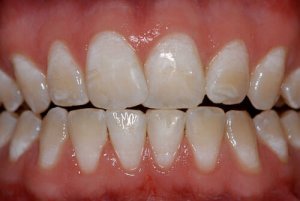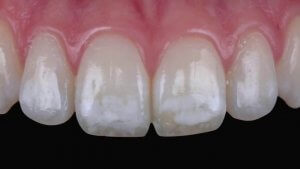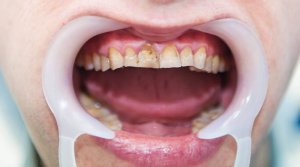Fluoride is an essential element for healthy teeth; it increases the mineralization of enamel and protects against decay. But overexposure while teeth are developing can lead to dental fluorosis, a condition which attacks enamel and can be quite unsightly. The most obvious sign of fluorosis is discoloration or white spots on the teeth.


If you want your baby or child to have healthy teeth but are worried about the effects of too much fluoride, this article should answer all your questions. We'll go over the fluorosis definition, what causes it, and how you can identify it. We also go over some possible treatments and ways to prevent white spots on teeth from excess fluoride consumption.
Do you want to know more about how to take care of your child's teeth? You can have a look at our entire collection of articles about dental care for babies and children.
Table of contents
What is dental fluorosis?
Dental fluorosis is an abnormality caused by excessive fluoride intake. It occurs when too much fluoride is consumed while the teeth are developing in childhood and permanently affects teeth. Fluorosis can affect the appearance of the teeth in a number of ways, depending on its severity. Fluorosis symptoms include:


- Cloudy white lines, spots, or marks on teeth
- Teeth with a chalky appearance
- Yellow or brown discoloration
- Surface irregularities
- Visible pits in tooth enamel
This webpage from the American Dental Association has some good fluorosis images which show mild cases of fluorosis in children.
Fluorosis is one of the few dental conditions that has nothing to do with poor oral hygiene. It occurs only when the teeth are developing, before they erupt into the mouth, and it's dependent on the fluoride we ingest (eat or drink), not just on the products we use in our mouths.
Fortunately, the majority of cases in the US are mild and the results are purely cosmetic and don't negatively impact the enamel. Fluorosis is also quite preventable, as there are several measures you can take to control your child's fluoride intake and reduce the risk of them developing fluorosis.
What causes white spots on teeth from fluorosis?
Fluoride is a naturally occurring mineral that's been proven to strengthen tooth enamel and help prevent tooth decay. But it's only beneficial when consumed in the correct quantities. Over-consumption of fluoride can mean that teeth and bones don't develop properly.
Fluoride is added to many toothpastes and mouthwashes in approved concentrations. It is also present in many water supplies (whether natural or added) and in lots of foods. The main risk of over-exposure comes from:
- Consuming water with high concentrations of fluoride
- Eating food contaminated with high levels of fluoride
- Swallowing toothpastes or mouthwashes containing fluoride
- Taking fluoride supplements when you're already getting enough from other sources
Further down we'll explain what you can do to safeguard against these risks.
What are the effects on dental health?
Although fluorosis affects the cosmetic appearance of the teeth, the good news is that it rarely impacts basic dental functions. People with moderate or severe fluorosis are more likely to experience sensitive teeth, and may be at greater risk of decay if the enamel structure is weakened in places.
Is fluorosis reversible?
Fluorosis damages teeth while they are developing. By the time they erupt, dental fluorosis reversal isn't possible. However, there are various cosmetic treatment options that can improve appearance.
When does fluorosis develop?
Fluorosis can form at any time when the teeth are developing, and this starts in the womb. Even after the teeth are fully developed, the effects of fluorosis can worsen if it's not treated appropriately.
Fluorosis in children


Children are at risk of fluorosis up to around age eight, which is when most of their teeth have fully developed (but not necessarily erupted). The exception is any wisdom teeth, which won't grow until a few years later.
The more fluoride a child consumes during childhood, the greater the likelihood of their teeth being affected by fluorosis – and the more severe it is likely to be. However, it bears repeating that in the US, even in areas with an artificially fluoridated water supply, the vast majority of fluorosis cases are mild.
White marks on baby teeth can be a sign of fluorosis in toddlers, and it's important to get it diagnosed early on. This way, you can take measures to moderate your child's fluoride consumption before it does any further damage to teeth that are still growing.
Fluorosis in adults
Fluorosis doesn't suddenly appear in adulthood, so if you notice white spots on your teeth which weren't there before, it's likely because of decalcification or some other problem which your dentist can diagnose.
That said, fluorosis which began in childhood may worsen into adulthood if it's not properly treated and monitored. For example, adults with fluorosis might have sensitive teeth, and may be susceptible to tooth decay if their tooth enamel is damaged or weakened in places.
Continued exposure to high levels of fluoride may cause skeletal and digestive disorders later in life. If you think you might have fluorosis which has been undiagnosed since childhood, go for a dental checkup.
Types of dental fluorosis
Tooth fluorosis manifests itself in different ways, depending on the severity of the condition. The greater our exposure to fluoride as a child, the more severe the type of fluorosis.
The types of fluorosis range from mild to severe, classed according to the visual appearance and physical surface of the tooth.


Mild fluorosis
Mild fluorosis appears as cloudy or pearly white lines, patches or marks on the surface of the tooth enamel. These deformations can appear on any part of the tooth, from the tip to the gum line. They may be so slight that only a dentist can pick up on them.
Moderate fluorosis
With moderate fluorosis, the white spots have a more chalky appearance, cover more of the tooth, and are much easier to see. Although this is not aesthetically pleasing, it doesn't cause any pain and the tooth can still function as normal.
Severe dental fluorosis


This is the most serious type of fluorosis. It can cause yellow or brown spots in addition to a chalky appearance on most of the tooth surface. The enamel may be rough, brittle or pitted, and parts of it may be missing completely. For some more detailed severe fluorosis pictures, click here.
How is dental fluorosis diagnosed?
There are several things that can cause white marks on teeth or other changes to tooth color. As well as fluorosis, decalcification, enamel hypoplasia, or dental caries might also be to blame. So although you might see white spots on your child's teeth and assume it's fluorosis, it's important to visit a dentist for proper diagnosis.
The dentist will perform a thorough examination to determine the cause of the problem. It's important to diagnose fluorosis as early as possible. If you notice white spots on baby teeth in your child, for instance, it may be possible to make some changes to avoid damage to their permanent teeth that are still developing. If you ignore the problem, their adult teeth may continue to be at risk.
Dental fluorosis treatment in the US
If you or your child are diagnosed with fluorosis, dental treatment will be recommended by your dentist depending on the severity of the condition. In mild cases, any fluorosis treatment is purely cosmetic. In more severe cases, it may serve a restorative purpose, too.
If you're wondering how to get rid of dental fluorosis, here are some possible ways of treating it – or, more specifically, restoring the appearance of the tooth and avoiding further damage.
Teeth whitening
Teeth whitening is effective at treating some cases of mild fluorosis. By bleaching the surrounding tooth enamel, the white marks become less obvious or disappear completely. Fluorosis teeth whitening doesn't involve removing any enamel, which is a benefit compared to the other options for treating fluorosis.
There are a variety of ways to whiten teeth, ranging from at-home whitening kits to professional in-office treatment. If you're thinking of whitening your teeth to get rid of white marks, we recommend consulting with your dentist first because in some cases whitening can accentuate any fluorosis stains.
Microabrasion or polishing
Dentists can sometimes get rid of white spots on teeth by using enamel microabrasion, wherein they use a mild abrasive to remove the very outer layer of enamel. Think of it a bit like sanding down the imperfections on a piece of wood, only much more gentle. You can see from the video below that this does a good job of reducing quite noticeable discoloration on the tooth enamel.
Dental bonding
If neither of the above options is suitable, dental bonding can be used to improve the appearance of the tooth. The dentist might need to remove some of the tooth structure first, and then will build it back up using a tooth-colored composite resin material (just like a white filling). The covering can be partial or complete, in which case it might be called a composite veneer.
Dental bonding not only evens out the color of the tooth; it also deals with any holes, chips, and other imperfections. You can expect the results to last for about five years before the bonding work needs to be re-done.
Veneers
Veneers are the most drastic way to fix fluorosis in teeth. After removing any damaged enamel, the dentist prepares the tooth surface by filing it down slightly and then applies a custom-made thin porcelain cover. Porcelain veneers look just like natural teeth when done well, and should last 10-15 years before needing to be replaced.
On the downside, this dental fluorosis treatment cost is around $500 – $2.500 per tooth, although you may be able to get them cheaper overseas.
Our guide to dental veneers has more information about this treatment, including the benefits of composite vs. porcelain. You can view a summary of all these fluorosis treatment options in the table below.
Whitening | Microabrasion | Bonding | Veneers | |
Can treat what type of fluorisis? | Mild | Mild to moderate | Mild to severe | Mild to severe |
Requires enamel removal? | No | Yes, a very thin layer | Yes | Yes |
Longevity | Several months | Permanent | At least 5 years | 10-15 years |
Cost | Home kits: $10 - $110; Professional: $300 - $1,800 | $50 - $500+ | $250 - $1,200 per tooth | $500 - $2,500 per tooth |
Can you get treatment for fluorosis on Medicaid?
Because fluorosis is treated in a number of different ways, there is no simple way to know if the treatment will be covered by federally-funded healthcare. Dental treatment on Medicaid is only offered in some states for adults, and purely cosmetic dental treatments such as teeth whitening and veneers may not be offered at all. However, if there is visible discoloration to a tooth caused by a medical condition, it's possible that your treatment will be covered.
If your older children have severe dental fluorosis, treatment is likely to be covered by Medicaid.
How to reduce the risk of excess fluoride consumption
It might seem like the best way to prevent fluorosis is to cut fluoride out of your child's life completely. But don't forget that fluoride is helpful for keeping teeth healthy, not only as they are developing but into adulthood. The key is to get the amount right; not too little, not too much. Follow these steps to minimize the risk of over-exposure to fluoride and therefore the risk of dental fluorosis in children:


- Check how much fluoride is in your water supply. It's naturally present to some degree in most places, and some local authorities add fluoride to the public water supply. You can find information about fluoride in US water supplies here. If you have a private water supply (e.g. a well), get it tested at least once a year.
- Don't give your child fluoride supplements unless instructed. Your doctor or dentist may recommend you give your child a fluoride supplement, but only if they aren't getting enough fluoride from other sources.
- Supervise your child's brushing. Once your child is using fluoride toothpaste, it's important they don't deliberately eat it or swallow too much while brushing. Use a smear of toothpaste for children under 3, and a pea-sized amount thereafter. Our kids' toothpaste guide has more useful information about choosing the right toothpaste and using it correctly.
- Don't give fluoride mouthwash to children under 6. They shouldn't need any mouthwash if they're brushing well, and there's a risk of them swallowing some.
- If you are pregnant or planning a pregnancy, talk to your dentist. They may recommend that you lower your fluoride intake (if you take supplements) as there is no evidence to suggest that fluoride intake during pregnancy helps prevent tooth decay in the child later on, but drinking water with fluoride shouldn't have any adverse effects.
Children in the US are routinely offered fluoride varnish as a preventive treatment. This involves painting a high-fluoride liquid onto the outside of the teeth once every few months. If you know your child already gets a lot of fluoride from your water or from another source, speak to your dentist or health provider before approving fluoride varnish treatment.
Studies show that children who receive regular fluoride treatments–once every 6 months–have up to 40% fewer cavities than those who do not receive this treatment. Adults and children both need fluoride. Even infants and toddlers can benefit. During the ages of 6 months to 16 years fluoride use is critical because of developing and erupting permanent teeth. Setting a strong foundation of healthy teeth will influence how your permanent teeth develop and their strength.
Consult with your dentist before purchasing any over-the-counter fluoride products. Not all are the same. Reputable products will carry the American Dental Association’s Seal of Acceptance which ensures that they have been carefully screened by the ADA’s Council on Scientific Affairs and have met the criteria for safety and effectiveness. Even then, it is vital that you follow the instructions carefully and keep them away from young children. Too much fluoride can have disastrous (and permanent) effects on teeth (dental fluorosis).
Dr. Catalina Botero, Li'l Sunshine Smiles Dentistry
Conclusion
It's great that you care about your child's dental health – and your own – but there is no need to shun fluoride completely. Now that you know about the potential risks of teeth fluorosis, you can take steps to ensure your child is not consuming too much fluoride from their water, food or toothpaste. And you know how to treat fluorosis if you're an adult with this condition.
The most important thing you can do on a daily basis is to make sure they brush their teeth twice a day but don't swallow the toothpaste.
And while most dentists recommend using toothpaste with fluoride, you can check out some fluoride-free toothpaste options if that interests you.
If you have noticed discoloration on your child's teeth or have any other concerns, visit your dentist for a professional opinion.
NHS: Fluoride. Consulted 14th December 2019.
USDA: USDA National Fluoride Database of Selected Beverages and Foods, Release 2. Consulted 3rd February 2020.
ScienceDirect: Dental Fluorosis. Consulted 14th December 2019.
World Health Organization: Fluorosis. Consulted 14th December 2019.




